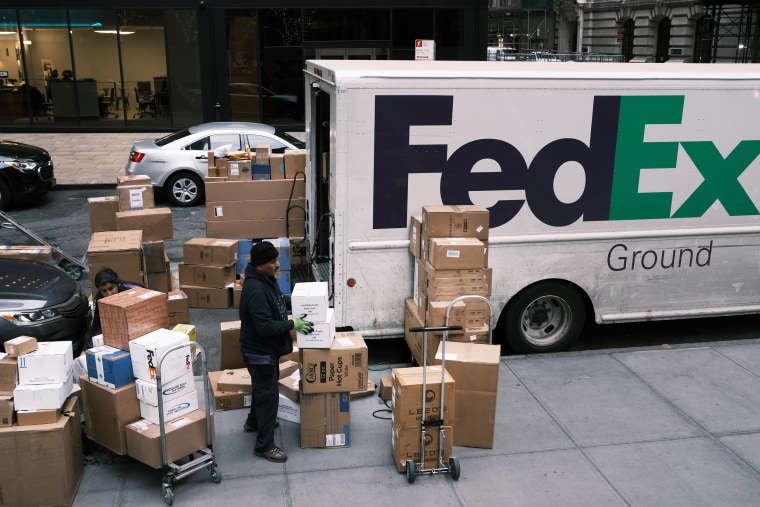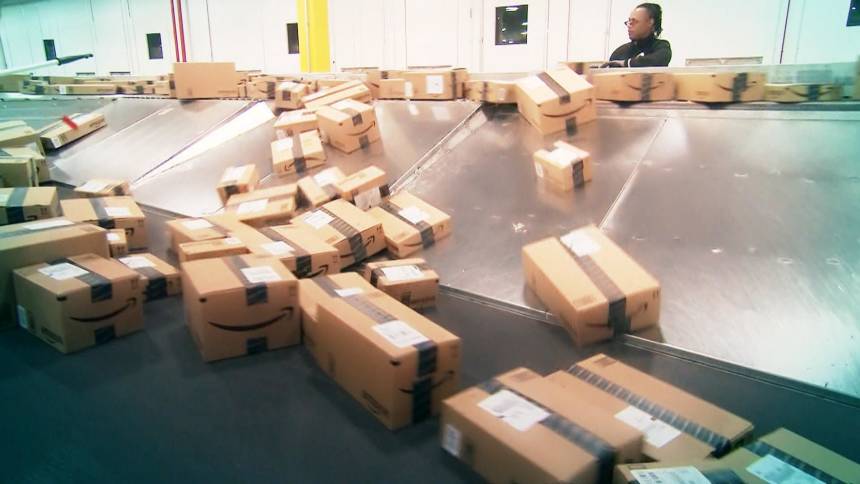Oggi li abbiamo trovati alla porta.
_______________________________________________________
Delivery dilemma: Americans are ordering more, but the U.S. can only handle so much
The delivery crunch is a year-round phenomenon that’s causing people to rethink the design of American cities.

By David Ingram (NBC News)
There's only so many boxes that can be delivered in a day.
Warehouse space is nearly full, with vacancy near an all-time low. Streets are crammed with delivery vans blocking traffic. City curbs are increasingly a turf war between delivery drivers and everyone else. Even grocery store aisles can feel crowded — at least, when staff for delivery services are scouring the shelves.
Americans are demanding more deliveries, and as a result, many of the things needed for delivery are becoming scarce. And with many companies pushing to meet that demand, industry experts say the U.S. faces a problem — its infrastructure can only handle so many deliveries.
The crunch has been extreme in the weeks leading up to Christmas, but it’s a year-round phenomenon, and it’s one that’s causing people up and down the delivery chain to rethink the design of American cities, streets and buildings.
“E-commerce has completely transformed the industrial market, and we’re still kind of wrapping our heads around it,” said Matthew Walaszek, an associate director of research at CBRE, a commercial real estate firm.
It’s a transformation years in the making and inspired by convenience. Amazon Prime launched in 2005, tantalizing consumers with two-day delivery and whetting their appetites for the parade of delivered goods that would follow: prepared food, groceries, gifts, paper towels, mattresses, wardrobe recommendations and nearly anything else that could fit in a box.
Established retailers have chased Amazon’s lead in home delivery, while startup companies are forgoing malls or other physical locations and selling directly to customers, through the mail or other delivery service.
“Seven years ago, thinking that you’d be getting cheeseburgers delivered by the millions was kind of crazy, right?” said Chris Baggott, CEO of ClusterTruck, a food and delivery company founded in 2015.
But the reckoning has arrived: The physical infrastructure of the country doesn’t yet match its delivery ambitions. There’s just too much stuff getting delivered.
Start with the warehouse space, from the massive 1 million-square-foot fulfillment centers to the “last mile” depots closer to city centers. Though the U.S. has added around 1 billion square feet of warehouse space in the past six years, the vacancy rate is near a historic low and rent is still rising, according to CBRE data.
“Our warehouses are stacked to the brim,” Walaszek said.
Developers have begun to think vertically. Last year, Prologis built the country’s first three-story warehouse in Seattle, with ramps so that delivery trucks can access the upper floors. Industry analysts say multifloor warehouses are beginning to make sense in areas where land is pricey, and for the first experiment Amazon and Home Depot signed on as tenants.
Now, similar buildings are in the works, including a planned four-story warehouse in a Brooklyn industrial park. (Multistory warehouses are already a reality in Asia, where they rise more than 20 stories high and have ramps long enough to accommodate foot races.)
A new model has popped up to rent the unused corners in warehouses, like an Airbnb but for spare capacity to store and ship inventory. Startups such as Flexe, Flowspace and CubeWork offer short-term rentals that are flexible on the amount of space and location — helpful for a retailer that doesn’t want to commit to leasing a whole building.
“Everybody is trying to figure out how to catch up with Amazon with two-day shipping,” said Dave Glick, chief technology officer of Flexe. But, he added: “The capital that Amazon has invested over the last 20 years, most likely no one is ever going to reproduce.”
Amazon has continued its investment beyond warehouses, building a delivery fleet that is now up to 30,000 trucks and vans, Bloomberg News reported last week, in a boon to the big automakers who manufacture the vehicles.
But absent the arrival of new vans, retailers have been enticing people to use their personal vehicles to deliver packages through Amazon Flex, Walmart’s Spark Delivery and companies such as Instacart, whose workers shop for and deliver groceries. This month, Old Navy struck a deal with Postmates for drivers to deliver last-minute Christmas gifts.
And it's not just gifts and food that people are having delivered. Companies that sell larger items — like Wayfair, Overstock and a raft of mattress startups — are increasingly shipping bulky items to doorsteps.
In at least some markets, managers for delivery companies say they have trouble finding and keeping enough drivers, who, with unemployment nationally at a 50-year low, may have other options.
That’s also creating some questions about safety.
“As demand grows, it becomes extremely difficult to find qualified people to do the job safely in the short amount of time that you have to find them and train them properly,” said Amber King, a former manager for UPS in Virginia.
The scarcity issue extends to the physical infrastructure of U.S. streets, which in most places have not been designed to accommodate delivery trucks in significant numbers. In New York City, more than 1.5 million packages are delivered daily, and they bring along gridlock, safety concerns and pollution, The New York Times reported in October.
“If we all keep on buying as we are year after year, without regard to the impact, we are doomed,” José Holguín-Veras, a professor at Rensselaer Polytechnic Institute, told Time magazine last year.
To try to help overwhelmed city planners, last year the Institute of Transportation Engineers published a 50-page Curbside Management Practitioners Guide, saying it wanted to help people in “optimizing curb space in this time of change.” Washington, D.C., is experimenting with new pick-up/drop-off zones, or PUDOs.

Social media is filled with complaints from people who dislike seeing all the delivery services in their neighborhoods, and some companies are looking for alternatives — whether it’s long-promised delivery drones, cargo bikes that first caught on in Europe or scooters that can fit into bicycle lanes.
“The issue is, there’s nowhere to park, and if you’re making multiple stops in that van, you have to find ‘nowhere to park’ multiple times,” said Max Smith, CEO of OjO Electric, a maker of battery-powered scooters currently being tested to deliver takeout food. “You have to double-park, and then you get tickets.”
Sometimes the answer has been to cut out final home delivery entirely. There are Amazon lockers, and some food delivery companies require customers to meet drivers at the curb rather than their front door.
Then there’s what retailers call BOPUIS: buy online, pick up in store.
“What is the final conveyance vehicle? Is it a delivery person with a pushcart going that last mile? Is it a courier with a satchel on her back? Or is it some form of airborne conveyance?” asked Benjamin Conwell, a former Amazon fulfillment executive who now advises companies on logistics for the real estate firm Cushman & Wakefield.
The logistics industry is going to learn a lot in the next several years, he said, and it may continue to feel big strains.
“That demand is not going to abate,” Conwell said. “We don’t see the basic trend tapering much at all.”